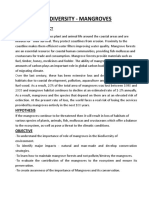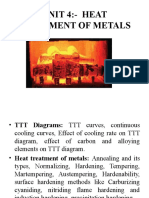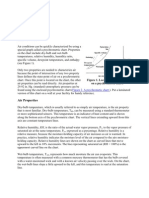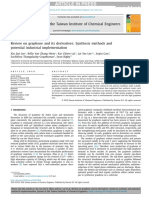Bad Effects of Festivals On The Environment
Bad Effects of Festivals On The Environment
Uploaded by
Sahil BohraCopyright:
Available Formats
Bad Effects of Festivals On The Environment
Bad Effects of Festivals On The Environment
Uploaded by
Sahil BohraOriginal Description:
Original Title
Copyright
Available Formats
Share this document
Did you find this document useful?
Is this content inappropriate?
Copyright:
Available Formats
Bad Effects of Festivals On The Environment
Bad Effects of Festivals On The Environment
Uploaded by
Sahil BohraCopyright:
Available Formats
Introduction:
Environment is the natural world which is made by the living beings (people, animals and the plants)
and land. Therefore it is the surroundings that affect the behaviour and development of a living
being or a thing. The surroundings may be living factors like plants, animals and decomposers and
non-living things like air, water, light, soil etc.
Human beings are the product of the environment. They are an important factor of the
environment. It is the environment that helps us for our survival, growth, development,
reproduction and health. No creature's existence is possible without the balance of the natural
elements. Thus, there must be a healthy environment for our sound living. The healthier the
environment the happier the living beings including humans.
However, knowing that the environment should be clean, healthy and non-polluted, the large scale
celebration of various festivals have degraded the quality of the environment.
The practice of immersion of Ganesh idols after the Ganesh festival in various cities is causing severe
water pollution which leads to the death of tonnes of fish and many aquatic creatures.
The immersion of Durga Statutes during the Durga pooja is also a cause of concern for
environmentalists. In Orissa alone 5,000 Durga pooja idols are made, most of them using harmful
paints.
Diwali, one of the important festivals in India has the distinction of polluting the environment to the
core. Newborns and aged people have a nightmarish experience because of the high levels of sound
caused by crackers during Diwali. Noise pollution on Diwali is between 69.7 db and 88.3 db which
are higher than the prescribed limit of 50 db. The decibel levels alarmingly high in metros and it may
reach up to 100 db.
The government, police, pollution control boards are suggesting many alternative ways to celebrate
festivals which does not pollute the environment. Even strict and stringent warnings are also given
to public to refrain from bursting crackers such as atom bombs, hydrogen bombs, bullet bombs,
thousand and ten thousand wallas. But it is all solely depend on the change of mind.
AIMS AND OBJECTIVES:
The project aims to understand and raise awareness about the bad effects of various
festivals on the environment and help us know how it degrades the environment and also
how can we reduce its ill effects on the environment. Festivals is of great significance in the
Indian culture because it marks a special event in its history and hence is a cause for
celebration. But since it has a lot of bad effects on the environment today, we must know
how to reduce it as much as possible and how to start using eco friendly products to pave
way for a healthier and more sustainable environment.
DIWALI:
Air pollution during Diwali
Clearly environmental groups and eco-clubs are fighting a losing battle. They come up with
awareness campaigns and slogans like Diwali is a festival of lights, not crackers, celebrate
an eco-sensitive Diwali this year, but nobody seems to take notice. Apart from the noise,
crackers release a lot of toxic gases like Sulfur dioxide and Nitrogen dioxide which can lead
to many health problems.
Impact of air pollution on health
Air pollution can lead to lung cancer, cardiovascular diseases, chronic respiratory diseases,
and allergies in adults. It can also cause acute respiratory infections in children.
Suspended particulate matter can cause asthma, bronchitis, and other respiratory disease
Sulfur dioxide can damage lungs and lead to lung disorders like wheezing and
shortness of breath.
Oxides of Nitrogen can cause skin problems, eye irritation, and cause respiratory
problems in children.
Chemicals used in crackers like lead, magnesium, cadmium, nitrate, sodium, and
others can have various harmful effects.
Festival of noise and pollution
Every Diwali, tradition, health and safety collide amidst celebrations.
Harmful effects of Chemicals Used in Crackers:
Copper: Poison to humans by ingestion. Inhalation of copper dust and fume causes
irritation in the respiratory tract. Absorption of excess copper results in "Wilson's
disease" in which excess copper is deposited in the brain, skin, liver, pancreas and
myocardium (middle muscular layer in the heart).
Cadmium: Can be poisonous to humans by inhalation, ingestion, intraperitonial, sub-
cutaneous, intra-muscular and intravenous routes. Cadmium absorption can damage
the kidneys and can cause anaemia. It is a potential human carcinogen. Cadmium
causes increased blood pressure and also a disease called "Itai--Itai", which makes
bones brittle resulting in multiple fractures.
Lead: Affects the central nervous system in humans. A poison if ingested, moderately
irritating. It can cause cancer of lungs and kidneys and an experimental teratogen.
When heated it can emit highly toxic fumes. In inorganic form, it is a general
metabolic poison and an enzyme inhibitor. Young children can suffer mental
retardation and semi-permanent brain damage by exposure to lead. Incase of lead
levels in blood, the disturbing feature is that the natural levels are very close to the
lowest safety limits.
Magnesium: Poison by ingestion, inhalation of magnesium dust and fumes can cause
metal fume fever. Particles embedded in the skin can produce gaseous blebs and a gas
gangrene. Dangerous fire hazard in the form of dust or flakes when exposed to flames.
Manganese in the air has adverse effects on humans. Poisoning takes the form of
progressive deterioration in the central nervous system.
Manganese: An experimental carcinogen and mutagen. Human toxicity caused by
dust or fumes. The main symptoms of exposure are languor, sleepiness, weakness,
emotional disturbances, spastic gait and paralysis.
Potassium: Dangerous fire hazard. If there is any confinement, an explosion can
occur.
Sodium: In elemental form, it is highly reactive, particularly with moisture with which
it reacts violently and therefore can attack living tissue. When heated in air, it emits
toxic fumes of sodium oxide. Dangerous fire hazard when exposed to heat and
moisture.
Zinc: Human skin irritant and effects pulmonary system. Pure zinc powder is non-
toxic to humans by inhalation but difficulty arises from oxidation (burning), as it
emits zinc fumes. Zinc is perhaps the least toxic of all heavy metals, in fact an
essential element in animal and human nutrition, still they become toxic when
absorbed in excess. Zinc stimulates the sensation of vomiting. An exposure to 150 mg
of zinc can stimulate the process of vomiting in an adult male.
Nitrate: Large amounts taken by mouth can have serious and even fatal effects. The
symptoms are dizziness, abdominal cramps, vomiting, bloody diarrhoea, weakness,
convulsions and collapse. Small repeated doses may lead to weakness, general
depression, headache and mental impairment. Also there is some implication of
increased cancer incidents among those exposed. Highly inflammable and on
decomposition they emit highly toxic fumes.
Nitrite: Large amounts taken by mouth may produce nausea, vomiting, cyanosis,
collapse and coma. Repeated small doses can cause a fall in blood pressure, rapid
pulse, headaches and visual disturbances. When heated, emit highly toxic fumes of
NOx.
Phosphorous in PO4: Poison to humans. Dangerous fire hazard when exposed to heat
or chemical reaction. Poison by inhalation, ingestion, skin contact and subcutaneous
routes. Ingestion affects the central nervous system. Toxic quantities have an acute
effect on the liver and can cause severe eye damage.
Sulphur in SO4: Poison to humans by inhalation an eye, skin and mucous membrane
irritant and corrosive, an experimental carcinogen. It chiefly affects the upper
respiratory tract and the bronchi. It may cause edema of the lungs or glottis, and can
produce respiratory paralysis. Source: Hazardous Chemicals Desk Reference,
N.Irving Sax and Richard J.Lewis
The conflict between competing interests in society - safety, health, and calm on the one
hand, and tradition on the other hand, has evolved over time, and the health effects are
receiving greater attention. Roshan Lal, owner of the New Royal Fireworks set up in 1928 in
Sadar Bazar says his family has been in the trade of crackers since the days of Prthviraj
Chauhan but now the business is not profitable. A combination of political will and public
support to limit health and environmental hazards, and at the same time maintain memorable
traditions, is needed to restore Deepawali to its pristine flavour.
Hindu Festivals Bring Pollution To Indias Waterways
As Hindus across India celebrate religious festivals in September and October, many are
concerned about the impact of toxic chemicals that are washing off of thousands of idols
immersed in rivers and lakes.
The pollution is killing fish and contaminating crops, said experts and environmentalists on
Monday.
The decorated statues are worshipped before they are taken to the rivers, laves and the sea,
where they are immersed in accordance with Hindu faith.
But environmentalists have raised questions about the non-biodegradable materials contained
in the idols such as plastic, cement, plaster of Paris and toxic dyes. Paints contain metals like
mercury, cadmium and lead, which can pass up the food chain from fish to human beings.
After the statues are immersed, the toxins then contaminate food crops when villagers use the
polluted water for irrigation, said Shyam Asolekar, science and engineering head at the
Indian Institute of Technology in Mumbai.
"Even small traces are extremely toxic as they persist in the body for a long time and
accumulate in the human tissues," said Asolekar, who has closely studied the effects of Hindu
customs.
Plaster of Paris, for example does not dissolve easily and it also reduces the oxygen level in
the water, said environmentalists.
Statue remains from festivities last year still float in rivers and water tanks in Mumbai, where
the annual "Ganesh Chaturthi" festival culminate in the immersion of some 160,000 statutes
some up to 25 feet high by millions of devotees.
Traditionally, idols were made from mud and clay and vegetable-based dyes were used to
paint them.
But commercialization of festivals such as Ganesh Chaturthi and Durga Puja has meant
people want bigger and brighter idols and are no longer happy with the eco-friendly statues.
"If we do not respect nature then we are not respecting god," said Manisha Gutman of
environmental group Eco Exist.
About 80 percent of Indias 1.1 billion population are Hindus. In recent years, their religious
festivals and customs have come under increasing scrutiny as public awareness of
environmental issues grows.
The spring festival of Holi involves the throwing of colored powder but studies have found
that the industrial powders used are often toxic and can cause asthma, temporary blindness
and even skin cancer.
Suit Challenges Noise Pollution During Hindu Festivals In Indian City
In the Indian city of Thane, a lawsuit has been filed seeking to require the city to enforce
noise ordinances against those celebrating Hindu religious festivals. According to yesterday's
Times of India, political parties have reacted negatively to the public interest lawsuit filed by
activist Dr. Mahesh Bedekar, saying that restrictions will dampen the festive spirit. Police
issued notices to 51 mandals, most formed by politicians, that exceeded permitted decibel
levels by 100% during Monday's Dahi handi celebrations. Meanwhile, according to another
Times of India article, today the Bombay High Court ordered the state to convene a meeting
with mandal representatives to see if the festival can be celebrated with less noise next year.
In anticipation of the upcoming Ganesh festival, the court directed the mayor to meet with
city corporators to discuss noise pollution, and told police not to issue permits for loud
speakers within 100 meters of major hospitals.
Air pollution during Diwali
Clearly environmental groups and eco-clubs are fighting a losing battle. They come up with
awareness campaigns and slogans like Diwali is a festival of lights, not crackers, celebrate an eco-
sensitive Diwali this year, but nobody seems to take notice. Apart from the noise, crackers release a
lot of toxic gases like Sulfur dioxide and Nitrogen dioxide which can lead to many health problems.
Impact of air pollution on health
Air pollution can lead to lung cancer, cardiovascular diseases, chronic respiratory diseases, and
allergies in adults. It can also cause acute respiratory infections in children.
Suspended particulate matter can cause asthma, bronchitis, and other respiratory disease
Sulfur dioxide can damage lungs and lead to lung disorders like wheezing and shortness of breath.
Oxides of Nitrogen can cause skin problems, eye irritation, and cause respiratory problems in
children.
Chemicals used in crackers like lead, magnesium, cadmium, nitrate, sodium, and others can have
various harmful effects.
Air pollution during Diwali
Studies by the Centre for Science and Environment (CSE) around Delhi conclude that this year,
RSPM levels during Diwali doubled compared to 2006. A Chandigarh Pollution Control Committee
(CPCC) study last year showed a 6-10% percent increase in air pollution during Diwali.
Clearly environmental groups and eco-clubs are fighting a losing battle. They come up with
awareness campaigns and slogans like Diwali is a festival of lights, not crackers, celebrate an eco-
sensitive Diwali this year, but nobody seems to take notice. Apart from the noise, crackers release a
lot of toxic gases like Sulfur dioxide and Nitrogen dioxide which can lead to many health problems.
Impact of air pollution on health
Air pollution can lead to lung cancer, cardiovascular diseases, chronic respiratory diseases, and
allergies in adults. It can also cause acute respiratory infections in children.
Suspended particulate matter can cause asthma, bronchitis, and other respiratory disease
Sulfur dioxide can damage lungs and lead to lung disorders like wheezing and shortness of
breath.
Oxides of Nitrogen can cause skin problems, eye irritation, and cause respiratory problems in
children.
Chemicals used in crackers like lead, magnesium, cadmium, nitrate, sodium, and others can
have various harmful effects.
GANESH CHATURTHI/DURGA POOJA:
Durga Puja is one of the auspicious occasion celebrated with great enthusiasum across India.
In modern times, festivals are getting commercialised and taking the shape of pomp and
show. Different communities set huge gigantic and attractive bright idols in order to compete
with other communities. This all leads to major problem of environment pollution. Idols
made by non biodegradable material and toxic paints contaminate water making it unfit for
survival of aquatic life and drinking purposes.
The material used for idols like POP is mainly the compound of gypsum, sulphur, phosphorus
and magnesium. Chemical paints comprise of mercury, cadmium; lead and carbon.
Immersion of idols with such poisonous and toxic elements raises the level of acidity, solid
matter, organic matter and heavy metals in water bodies. These materials dont dissolve
readily and lowers the oxygen level in water adversely affecting the aquatic life.
In order to come out of such problems and enjoy festival with the same spirit, devotees
themselves should give a serious thought over the methods of celebrations and should turn to
eco friendly idols for their celebrations. Even Government should also take a step towards
this burning issue and set strict guidelines for craftsmen to use eco-friendly materials
andorganic paints.
Environmental Consciousness Amongst People
It is a relief to notice that the awareness about the environmental impacts of celebrating Holi are
being brought to light by various NGOs. And gradually, more and more Indians are choosing to turn
to a more natural and less wasteful way of playing Holi.
Shocking Pollution during the Ganesh Festival
Yesterday was an important day. It was Anant Chaturthi the culmination of a ten-day long
Ganesh Festival, one of the most important festivals of western India. It was a day of great
joyousness and celebrationbut it has an ugly side. The environmental damage it causes.
Thousands of idols made from harmful materials like plaster of paris and toxic metals,
coated with deadly paints containing mercury, cadmium, lead and carbon enter our water
bodies. These idols, some of them gigantic in size, are immersed in lakes, rivers and the sea.
Just Mumbais sea takes in about 1.5 lakh (1 lakh = 100,000) idols every year! Is it any
wonder then then oxygen levels in the water bodies fall by about 50 per cent immediately
after the 10-day Ganeshutsav festival?
Not many care
Although there are organisations working towards creating awareness about the benefits of
using eco-friendly idols and state governments do issue guidelines about immersions, not
much is happening on the ground. Although there are specially prepared tanks for
immersions, people dont prefer to use these, and few are interested in eco-friendly idols. It
was heartening to see Harsha actually try and find out the situation on the ground. He
trudged four hours in the hot sun in Pune to find out if people were using eco-friendly idols.
His findings:
As I continued my search in the streets of Pune, I came across many idols-made of materials
as varied as PoP, Silver, Tin Foil and Thermocol, but not the green Ganesha. Thats what I
was looking for..an idol made of clay and a pandal that used eco-friendly materialsI must
have walked for at least 20 km, clicking hundreds of pix on the way. I could not find a single
idol made of clay, nor a pandal which didnt use the papi materials PoP and Thermocol.
Well, finally he did find a green pandal, but no idol. This then is the reality. No one cares.
And we are not just talking of the masses here. I have tried to convince several people I
know and while they agreed with me in theory, none of them actually went and bought an
eco-friendly idol. In fact one lady told me point blank: When there is a law against it well do
it! This even though they clearly see the water bodies around them getting polluted. I dont
believe this is due to religious reasons, but due to apathy and lack of civic sense.
What actually happens?
Here are the results of a scientific study done on a body of water in Andhra Pradesh, the
Hussainsagar Lake. After examining the water before and after immersion the scientists
found that the concentration of substances like calcium, magnesium, molybdenum and
silicon concentrations increased significantly. Also, it was found that concentrations of
heavy metals like arsenic, lead and mercury had increased. Metals like lead and mercury are
particularly worrisome as they are dangerous to health and can damage the heart, kidneys,
liver, circulatory system and central nervous system.
Besides polluting the water, they reach humans via the food chain, when humans consume
fish and other sea-food. If the fish survive that is! Because hundreds of fish are found dead
after the immersions.
The picture on the right is of a beach right after an immersion and that is what the tide has
brought in. The site from where I took the photo has other very vivid picturesif you want
to see them just click on the picture.
If people dont listen, we need the laws
The problem is that politicians dont want to take tough action as they are afraid of
upsetting the public as this is a religious issue. But I think it isnt. Traditionally, we used mud
idols and natural colours. These polluting idols are a modern invention and nothing to do
with religion!
No one is banning immersion. Or denouncing it. To put in place laws to make it compulsory
to make idols out of an eco-friendly material should not hurt religious sentiment. All we will
be doing is going back to the way the festival was traditionally celebrated. An information
campaign to this effect will go a long way in educating those who think that using poisonous
materials are what God commanded or that this was how it was traditionally done. I am
sure that a public information campaign which enumerates the amount of life that is
destroyed will impact a lot of people as quite a few Hindus are vegetarians who are against
killing of animals even for food.
I wonder if it is a powerful lobby of businessmen and those in the trade of manufacturing
and selling these poisonous idols who are making the politicians drag their feet on this one.
Because in this case it is only the politicians who can help us with laws.
Update: I am adding this link which talks of the dangers to flora and fauna because the idols
dont dissolve. They go to the river bed and affect the plant life. I thought this was pretty
obvious and had therefore not added this link before but from some comments I realise that
people are not aware of this fact.
Visual pollution during the Ganesh Festival
The religious fervour and euphoria of the ten days of Ganpati Bappa is over. People who fled
the city to escape the din (there is considerable amount of sound pollution due to the use of
loudspeakers) and the crowds, have come back. Politicians are conducting drives to clear
the debris on the beaches. And many of us regret the environmental damage. Another thing
we want to put behind us are the instances of intimidation/extortion before the start of the
celebrations (to collect money for the Ganesh mandals).
There are two other negative aspects. One concerns aesthetics and the other, the gross
commercialisation of the festival. I am not talking of the loud filmi music played at the
mandals, but the presence of brands. Whether its Idea or Hero Honda, or Lizzat Papad,
scores of brands were given permission by the municipality to put up posters and banners
and hoardings acrosss Pune city, particularly on roads with the mandals. I am not sure what
the financial arrangement was here, how much the mandals got, but I am sure they got
something too.
Even if they didnt, I dont see why a religious festival has to become an opportunity for the
government to make a few extra bucks. All billboard norms were thrown to the wind! I am
not in Pune now, but I wonder if these banners have been removed or whether they have
been carelessly discarded and are rotting in some ditch! The government knows that no one
will protest because the minute anything is religious people bear it in silence. People are
afraid that if they protest others could well question their faith in God. How else to explain
the uglification of a city and peoples tolerance levels? I cannot believe that anyone thinks
that polluting the city with ad banners has anything to do with religion.
These are some of the pictures I took during the Ganesh Festival. They speak louder than
words.
Air pollution levels in big cities are appalling at the best of times and are a growing cause for
concern. The Respirable Suspended Particulate Matter (RSPM) dust, fumes, smoke, and
gases is way above permissible limits in many of our big cities. This level sees a quantum
jump during festivals, the main culprits being crackers, inflammable substances, and
artificial colors.
You might also like
- Arunachal PradeshDocument6 pagesArunachal PradeshDev Sagar67% (3)
- 3 Determination of Complex Ion by Jobs MethodDocument2 pages3 Determination of Complex Ion by Jobs Methodvishwanathz47No ratings yet
- Project Report On Survey of Celebration of Ganesh Festival by Ecofriendly MannerDocument11 pagesProject Report On Survey of Celebration of Ganesh Festival by Ecofriendly Mannerjunaid86% (43)
- Pollution of Ganga and Yamuna Rivers and Effects of Air Pollution On Taj MahalDocument3 pagesPollution of Ganga and Yamuna Rivers and Effects of Air Pollution On Taj Mahalblah63% (8)
- Callister Solutions of Ch08Document42 pagesCallister Solutions of Ch08Malika Navaratna100% (1)
- Project 20-Pollution Due To FestivalsDocument6 pagesProject 20-Pollution Due To FestivalsUjjval Nagota100% (1)
- PROJECT 21 Pollution Due To FestivalsDocument4 pagesPROJECT 21 Pollution Due To FestivalsDevdutt Kumar100% (1)
- Festivals of India Impact of Festivals On EnvironmentDocument30 pagesFestivals of India Impact of Festivals On EnvironmentPriya Sharma50% (2)
- Impact of Festivals On EnvironmentDocument7 pagesImpact of Festivals On EnvironmentMohit Punjabi50% (4)
- Project Report On Survey of Celebration of Ganesh Festival by Ecofriendly MannerDocument11 pagesProject Report On Survey of Celebration of Ganesh Festival by Ecofriendly MannerPranjali DhamaneNo ratings yet
- Survey On Eco Friendly Ganesh IdolsDocument11 pagesSurvey On Eco Friendly Ganesh Idolsjuhikarande4347100% (1)
- Effects of Festivals On EnvironmentDocument13 pagesEffects of Festivals On EnvironmentHemantJ143100% (4)
- Festivals of India Impact of Festivals On EnvironmentDocument27 pagesFestivals of India Impact of Festivals On EnvironmentJasvinder Singh80% (30)
- Project 24 - Biodiversity - MangroovesDocument7 pagesProject 24 - Biodiversity - MangroovesUjjval Nagota100% (2)
- Ganga River ProjectDocument35 pagesGanga River ProjectDevendra Sharma87% (15)
- Unity in DiversityDocument4 pagesUnity in Diversityrabithacr100% (2)
- Art Integration ProjectDocument21 pagesArt Integration ProjectAyush Janghel100% (1)
- Odisha Natural ResourcesDocument7 pagesOdisha Natural ResourcesSangram PandaNo ratings yet
- Green India Clean IndiaDocument10 pagesGreen India Clean IndiaKKSNo ratings yet
- A Project On Swami Vivekananda's Contribution Towards EducationDocument15 pagesA Project On Swami Vivekananda's Contribution Towards Educationzzz100% (3)
- Festival of ChattisgarhDocument7 pagesFestival of ChattisgarhAnshika UniyalNo ratings yet
- The Making of A Global World 1Document6 pagesThe Making of A Global World 1SujitnkbpsNo ratings yet
- Polluted SiteDocument14 pagesPolluted SiteDineshNo ratings yet
- English Project 2023Document15 pagesEnglish Project 2023Lofu Louis BerlinNo ratings yet
- Contrasting The Rich Histories of Rajasthan and Nagaland 20230620101653GHHyDocument7 pagesContrasting The Rich Histories of Rajasthan and Nagaland 20230620101653GHHythevolecitorNo ratings yet
- Project On Indian CultureDocument37 pagesProject On Indian CulturePrafful Agarwal67% (3)
- Art Integration Project (English), Saurabh KumarDocument16 pagesArt Integration Project (English), Saurabh KumarKaushal Kishor KumarNo ratings yet
- E.V.S. ProjectDocument77 pagesE.V.S. ProjectPrashantChauhan71% (14)
- Ganga Action Plan IndiaDocument24 pagesGanga Action Plan IndiaPranav Choudhary40% (5)
- Chemistry Class 10 Project by ShriyaDocument11 pagesChemistry Class 10 Project by ShriyaSiddhi KawhaleNo ratings yet
- MainDocument51 pagesMainJitesh Joya100% (1)
- Tinsukia College: (Project On Visited Polluted Site)Document9 pagesTinsukia College: (Project On Visited Polluted Site)Raju SharmaNo ratings yet
- English Project Topic: William Shakespeare: Contents: BiographyDocument6 pagesEnglish Project Topic: William Shakespeare: Contents: BiographyAyush Chandra0% (1)
- Pottery of ManipurDocument15 pagesPottery of Manipurarorashrishti997decNo ratings yet
- Evs Project Air Pollution PDFDocument2 pagesEvs Project Air Pollution PDFChuck70% (20)
- English ProjectDocument8 pagesEnglish ProjectPrasanna kudale100% (1)
- Ozone Layer ProjectDocument20 pagesOzone Layer ProjectAMIN BUHARI ABDUL KHADER100% (5)
- A Comparative Study On The Ecosystems of Odisha and PunjabDocument6 pagesA Comparative Study On The Ecosystems of Odisha and Punjabupasna410No ratings yet
- Global Warming ProjectDocument29 pagesGlobal Warming ProjectAngelina Poojari88% (8)
- Geography (Practical File) XiiDocument77 pagesGeography (Practical File) Xiishubhamsoumyadas779No ratings yet
- Waste Management Notes Class 10 ICSEDocument2 pagesWaste Management Notes Class 10 ICSEzoha afshan67% (3)
- Khushwant Singh: Personal LifeDocument9 pagesKhushwant Singh: Personal LifeSAURABH VERMANo ratings yet
- Wildlife Conservation in India: Ecological Trauma!Document29 pagesWildlife Conservation in India: Ecological Trauma!Siddharth NyatiNo ratings yet
- Dadra and Nagar HaveliDocument15 pagesDadra and Nagar HaveliKunal BhatnagarNo ratings yet
- Folk Dance of NagalandDocument2 pagesFolk Dance of NagalandShaurya SoniNo ratings yet
- Art Integrated Project Work-1Document8 pagesArt Integrated Project Work-1EKANSH DANGAYACH 2021261950% (2)
- Ek Bharat Shreshtha Bharat: Haryana & TelanganaDocument13 pagesEk Bharat Shreshtha Bharat: Haryana & TelanganaYamini Singh SisodiaNo ratings yet
- Wildlife Conservation EffortsDocument18 pagesWildlife Conservation EffortsAravind SatheshNo ratings yet
- What Is Indigo Sharecropping AslDocument15 pagesWhat Is Indigo Sharecropping AslBOLDNo ratings yet
- Karnataka Vs LadakhDocument3 pagesKarnataka Vs Ladakhprafullaramesh.gangisetti100% (1)
- Daman and Diu - (English Project)Document10 pagesDaman and Diu - (English Project)Padma Mohan100% (1)
- Deforestation in IndiaDocument5 pagesDeforestation in IndiaChahak UpadhyayNo ratings yet
- Andman and NicobarDocument8 pagesAndman and NicobarSamyak JainNo ratings yet
- Geography Project ICSE - 2022Document5 pagesGeography Project ICSE - 2022D R.BarmanNo ratings yet
- Report Writing Class 12 EnglishDocument3 pagesReport Writing Class 12 Englishdivanshu2006yadav100% (1)
- Chem Art Integrated ProjectDocument12 pagesChem Art Integrated ProjectAnika MohantaNo ratings yet
- EVS-Yamuna Biodiversity ParkDocument7 pagesEVS-Yamuna Biodiversity ParkSharmishtha SamalNo ratings yet
- Oc ProjDocument5 pagesOc ProjSujatha Shetty100% (1)
- Festivals and PollutionDocument7 pagesFestivals and PollutionSingh Mayra50% (2)
- DOC-20230627-WA0000Document200 pagesDOC-20230627-WA0000devanandask2No ratings yet
- Effects of Various Types of PollutionDocument22 pagesEffects of Various Types of Pollutionayushyadav5775No ratings yet
- OCMDocument7 pagesOCMchimboriNo ratings yet
- Various Functions of The DepartmentsDocument7 pagesVarious Functions of The DepartmentsSahil BohraNo ratings yet
- Mountainous and Littoral ForestsDocument13 pagesMountainous and Littoral ForestsSahil Bohra0% (1)
- Rise of DictatorshipDocument6 pagesRise of DictatorshipSahil Bohra100% (2)
- Conservation of TreesDocument3 pagesConservation of TreesSahil BohraNo ratings yet
- Fiche - Prod - TFC - UD - 75 - 350-ACI - en - V04 Version TempDocument2 pagesFiche - Prod - TFC - UD - 75 - 350-ACI - en - V04 Version TempDifa LiuNo ratings yet
- Luviskol R Va 64w PdsDocument2 pagesLuviskol R Va 64w PdsSamir MaksoudNo ratings yet
- Unit 4:-Heat Treatment of MetalsDocument52 pagesUnit 4:-Heat Treatment of MetalsRushikesh Kale100% (1)
- Bahir Dar Universtity Department of Material Science and EngineeringDocument5 pagesBahir Dar Universtity Department of Material Science and EngineeringKetemaw ZemeneNo ratings yet
- TDS Gum Rosin Perhutani Rev December 2021Document1 pageTDS Gum Rosin Perhutani Rev December 2021faisalNo ratings yet
- Indian Fertilizer Scenario 2013Document234 pagesIndian Fertilizer Scenario 2013the_hunter71181100% (1)
- Aluminum Sulfate: Material Safety Data Sheet (MSDS)Document4 pagesAluminum Sulfate: Material Safety Data Sheet (MSDS)DARWIN CLAVIJONo ratings yet
- Biochemistry of Ageing.Document52 pagesBiochemistry of Ageing.deva_baraskar88% (8)
- Elective Project - TuberculosisDocument30 pagesElective Project - TuberculosisKinjal KoshtiNo ratings yet
- Alkalinity ControlDocument6 pagesAlkalinity ControlraotalhaNo ratings yet
- Assignment 2Document2 pagesAssignment 2Ghulam MurtazaNo ratings yet
- Textbook Notes: ClassificationDocument15 pagesTextbook Notes: Classificationghadeer alkhayatNo ratings yet
- Enchem Activity 2 SubstanceDocument4 pagesEnchem Activity 2 SubstanceNala, Vangie A.No ratings yet
- SJD (CEP) Vertical Multistage Can Pump For Condensate ExtractionDocument5 pagesSJD (CEP) Vertical Multistage Can Pump For Condensate ExtractionClke OGNo ratings yet
- NT PotentialMiningDevelopmentsDocument13 pagesNT PotentialMiningDevelopmentsho100hoNo ratings yet
- P C PDocument5 pagesP C PAli BabaNo ratings yet
- Dosing SystemDocument27 pagesDosing Systemmanoj nirgude100% (5)
- 1901500bojko Branc A Definition of The Mathematical Model of Combustion Process in The StoveDocument5 pages1901500bojko Branc A Definition of The Mathematical Model of Combustion Process in The StoveFrank MedrosNo ratings yet
- 2012 Minerals Commodity SummariesDocument201 pages2012 Minerals Commodity SummariesnationalminingNo ratings yet
- Kota Career Academy: Chemistry DPDDocument5 pagesKota Career Academy: Chemistry DPDDeepNo ratings yet
- Problems1 101Document11 pagesProblems1 101Karl Angelo Pacolor0% (1)
- MsdsDocument5 pagesMsdsAndi FirdausNo ratings yet
- Facts at Your Fingertips-201101-Hansen Solubility Parameters (HSP)Document1 pageFacts at Your Fingertips-201101-Hansen Solubility Parameters (HSP)onizuka-t2263No ratings yet
- DF5 - Modelling Inflow PerformanceDocument6 pagesDF5 - Modelling Inflow Performanceadnan0307No ratings yet
- Exercise 4 Plastic Deformation by Oscillating Force and Observation of Strain Hardening On A CantileverDocument7 pagesExercise 4 Plastic Deformation by Oscillating Force and Observation of Strain Hardening On A CantileverSandip GaikwadNo ratings yet
- Review On Graphene and Its Derivatives Synthesis Methods and Potential Industrial ImplementationDocument18 pagesReview On Graphene and Its Derivatives Synthesis Methods and Potential Industrial ImplementationThúy DuyNo ratings yet
- CSEC Physics January 2010 P2 PDFDocument18 pagesCSEC Physics January 2010 P2 PDFcxcchemistryNo ratings yet
- SSC Je Mechanical Engineering 22 03 2021 Shift 2 99Document11 pagesSSC Je Mechanical Engineering 22 03 2021 Shift 2 99Anto KevinNo ratings yet





























































































